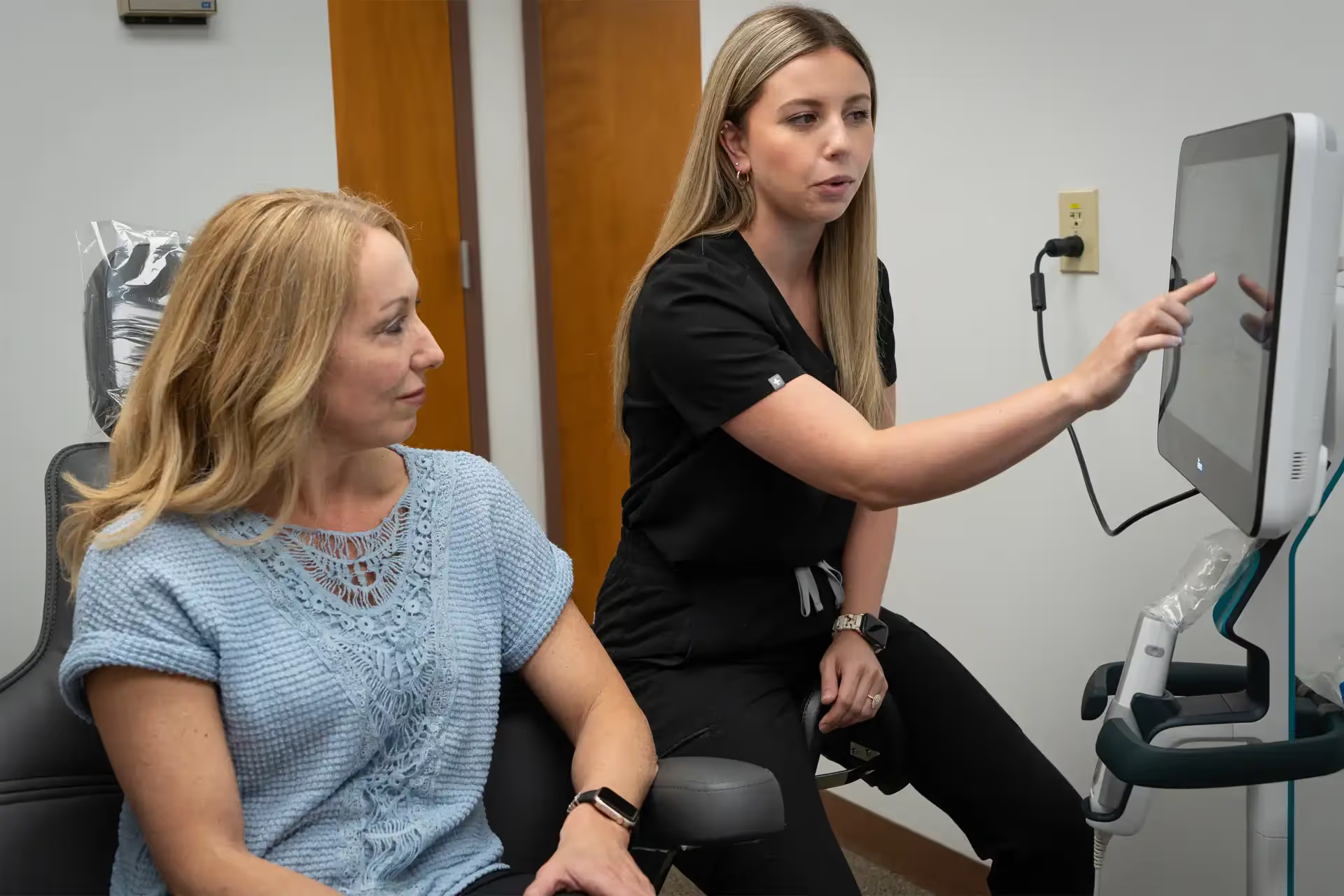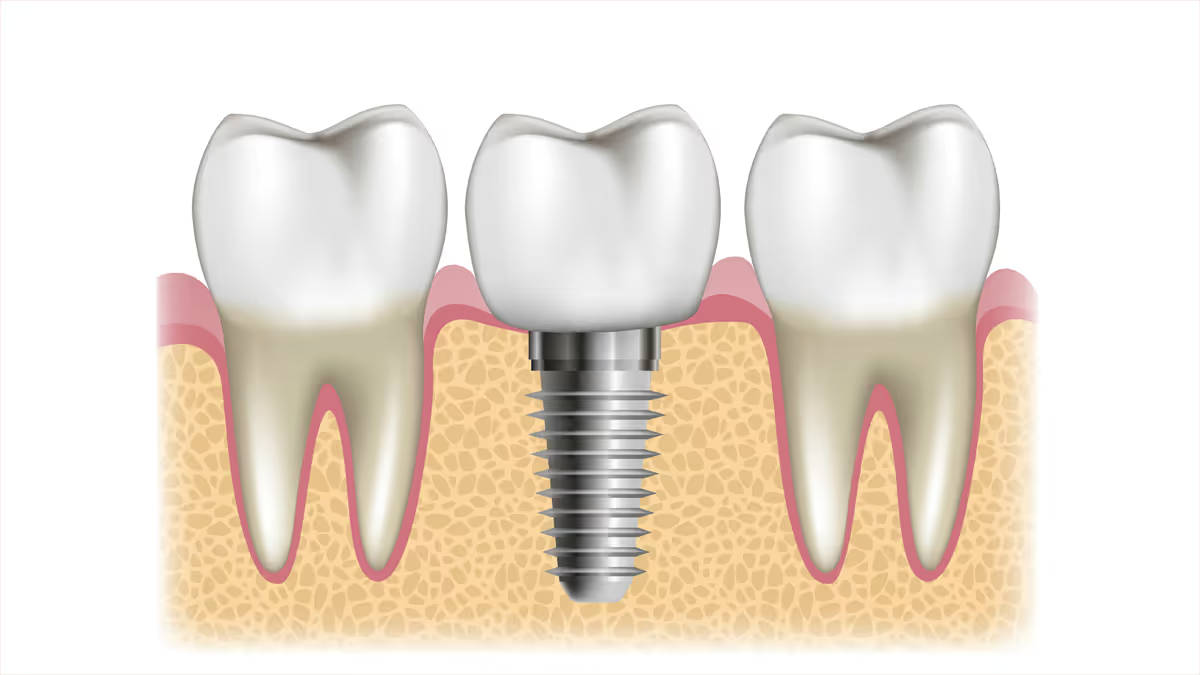
Dental implants are the best way to replace missing teeth. But an implant alone will only replace a tooth's root. An implant restoration, like a dental crown, can be used to complete your smile.

DID YOU KNOW?
Single-tooth dental implants are the most common type of implant, and use a single dental crown to replace one missing tooth.
Why should I get an implant restoration?
Implant restorations are a necessary part of any dental implant treatment plan. The implant itself is just a small piece of metal that acts as an artificial tooth root. To restore the tooth completely, you need a restoration like a dental crown, bridge, or set of dentures. Together, your dental implant and your implant restoration will keep you smiling for decades to come.
Single-Tooth Restorations
Dental crowns are the most common implant restoration, and are used to restore a single missing tooth. They function exactly as a natural tooth does, and they blend seamlessly with the rest of your smile.

Keeping Care Accessible
Everyone deserves to love their smile. That’s why we make it easy to pay for your treatment in a way that fits your budget and lifestyle.
Flexible Payment Options


Trusted Labs
We work with exceptional dental labs to custom-craft your implant restorations. Your beautiful crown will blend seamlessly with your natural smile, and is sure to stand the test of time.

see what happy patients
are saying!
The Benefits of Implant Restorations
Versatile Smile Restoration
Implant restorations can be used to replace one tooth with a crown, multiple teeth with a bridge, or a full mouth of teeth with implant-supported dentures. Implant restorations look, feel, and function just like real teeth. No matter how many teeth you’ve lost, you may be a good candidate for treatment with dental implants and an implant restoration.
Long-Lasting Results
When you care for them properly, your dental implants and your restorations could last decades. This is much longer than alternatives like dentures and traditional dental bridges, which makes implants a great long-term investment.
Minimal Special Care
If you get a single-tooth restoration with a dental crown, you can just treat it like a normal tooth, and it’s easy to care for implant-supported bridges and dentures, too. This makes your life more convenient.
The Implant Restoration Treatment Process
Placement
Once your treatment is given the green light, your doctor will work with you to schedule your oral surgery and develop a personalized surgical plan. During the procedure, your oral surgeon will carefully create an opening in your gums and skillfully position a dental implant directly into your jaw bone. Afterward, the surgical site will be thoroughly cleaned and carefully sutured to kickstart the healing process.
Healing & Osseointegration
Experience a seamless recovery after your implant surgery. As your gums and jawbone heal, you'll notice remarkable progress in just 1-2 weeks, with the incision area fully healed. However, the true magic happens over the next 3-6 months as the implant securely fuses with your jawbone through the incredible process of osseointegration. Rest assured, our dedicated team will be there every step of the way, scheduling follow-up appointments during this crucial phase to ensure your healing is on track.
Applying the Restoration
After the implant has seamlessly fused with your jaw, it's time for the final step - placing your restoration. This is the part of the implant that is visible and resembles a natural tooth. Our expert team will custom design a dental crown that perfectly matches your smile. With the crown securely attached to the titanium implant through an abutment, your smile will be flawlessly restored. Get ready to show off your new, confident smile!
Before & Afters
stop scrolling and start straightening!
Frequently Asked Questions
What is a single tooth implant?
A single tooth implant is a popular dental solution that consists of three components. First, there is a titanium implant, which is shaped like a screw and serves as the foundation. Second, an abutment is used to connect the implant to the restoration. The restoration is the third component and is typically a dental crown that closely resembles a natural tooth. Unlike removable partial dentures, single tooth implants are stable and do not move or shift.
How are dental implants made?
Dental implants are made using high-quality titanium in reputable laboratories. These labs offer a variety of standard post sizes for the implants. The restoration, on the other hand, is a personalized prosthetic that is tailored to meet each patient's specific needs and aesthetic preferences. Your dentist may create the restoration in-office using advanced technology or send detailed impressions to a trusted laboratory. The laboratory will then craft a durable and natural-looking crown made from porcelain, which closely resembles tooth enamel. Once completed, the crown is firmly attached to the implant by your dentist.
How long will my dental implant last?
With proper placement by an expert and regular maintenance, dental implants can last for 30 years or even a lifetime. However, it's important to note that the restoration may need to be replaced over time due to regular wear and tear from chewing and biting. Just like traditional crowns or dentures, regular visits to the dentist will allow you to monitor the condition of your restoration and the health of your implant, ensuring the longevity of your smile.
Can my dental implant become infected?
While it is possible for dental implants to become infected, this complication is extremely rare and usually occurs when the implant is not properly cared for after the placement surgery. By following your doctor's post-operative instructions, the chances of developing an infection are very low. It's important to maintain good oral hygiene, including regular brushing, flossing, and professional cleanings, to keep your implant and surrounding tissues healthy.
Do dental implants stop bone loss?
Yes, dental implants are the only tooth replacement option that can prevent bone loss. When you lose a tooth, the jawbone no longer receives stimulation from chewing and biting, causing it to deteriorate over time. This can lead to a weakened jaw and the shifting or loosening of surrounding teeth. Dental implants mimic the function of natural tooth roots by being placed directly into the jawbone. This stimulation from chewing and biting forces helps to maintain the integrity of the jawbone and prevent bone resorption.
Have more questions?

